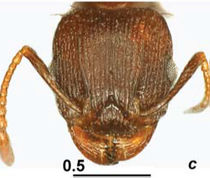Key to Tetramorium striativentre species-group
This worker and queen key is based on: Radchenko, A.G. and Scupola, A. 2015. Taxonomic revision of the strativentre species group of the genus Tetramorium (Hymenoptera, Formicidae). Vestnik zoologii. 49:219–244.
You may also be interested in
1
- Whole surface of first gastral tergite densely longitudinally striato-punctated . . . . . 2
- Only basal half of first gastral tergite densely longitudinally striato-punctated, remainder part of tergite smooth and shiny or at most with fine superficial microreticulation . . . . . 5
2
return to couplet #1
- Frontal carinae not curved, gradually converging anteriorly, so that frontal lobes not extended laterally (FLI in workers 1.00–1.06, mean 1.01, in queens < 1.00, mean 0.96); longitudinal rugosity on head dorsum relatively fine, number of rugae between frontal carinae level with the eyes > 15 (mean in workers 18, in queens — 21). Petiolar node transversal (mean PndI in workers 1.34, in queens — 1.78); both petiolar node dorsum and postpetiolar dorsum with regular longitudinally-concentric rugae. Propodeum with short denticles (mean ESLI in workers 0.10, in queens — 0.08) . . . . . Tetramorium striativentre
- Frontal carinae curved above antennal insertions, frontal lobes distinctly extended (FLI ≥ 1.08, means in workers 1.12 … 1.17, in queens 1.09 … 1.15); longitudinal rugosity on head dorsum various. Petiolar node of various shape, petiolar node dorsum with sinuous longitudinal rugae, postpetiolar dorsum with longitudinal rugae. Propodeum with longer teeth or even thin spines (means ESLI in workers 0.15 … 0.19, in queens 0.11 … 0.17) . . . . . 3
3
return to couplet #2
- Petiolar node subcircle (mean PndI in workers 1.02, in queens — 1.40). Longitudinal rugosity on head dorsum relatively fine, number of rugae between frontal carinae level with the eyes > 15 (mean 23) . . . . . Tetramorium schneideri
- Petiolar node transversal (means PndI in workers 1.20 … 1.35, in queen 1.40). Longitudinal rugosity on head dorsum coarser, number of rugae between frontal carinae level with the eyes < 15 (means 12 … 13) . . . . . 4
4
return to couplet #3
- Scape somewhat shorter, mean SI1 0.75, SI2 0.78. Petiolar node somewhat narrower, mean PndI 1.20; postpetiole somewhat narrower, mean PPI1 0.77, mean PPI2 0.36. Gena only somewhat longer than maximal diameter of eye, mean OI2 1.04 . . . . . Tetramorium saudicum
- Scape somewhat longer, mean SI1 0.80, SI2 0.84. Petiolar node somewhat wider, mean PndI 1.35; postpetiole somewhat wider, mean PPI1 0.70, mean PPI2 0.39. Gena distinctly longer than maximal diameter of eye, mean OI2 1.10 . . . . . Tetramorium sabatinellii
5
return to couplet #1
- Mesosomal dorsum and waist dorsum with sinuous longitudinal rugae. Longitudinal rugosity on head dorsum coarser, number of rugae between frontal carinae level with the eyes ≤ 15 . . . . . Tetramorium kabulistanicum
- Mesosomal dorsum with more regular, almost straight longitudinal rugae, waist dorsum with regular longitudinally-concentric rugae. Longitudinal rugosity on head dorsum less coarse, number of rugae between frontal carinae level with the eyes ≥ 20 . . . . . Tetramorium pisarskii











